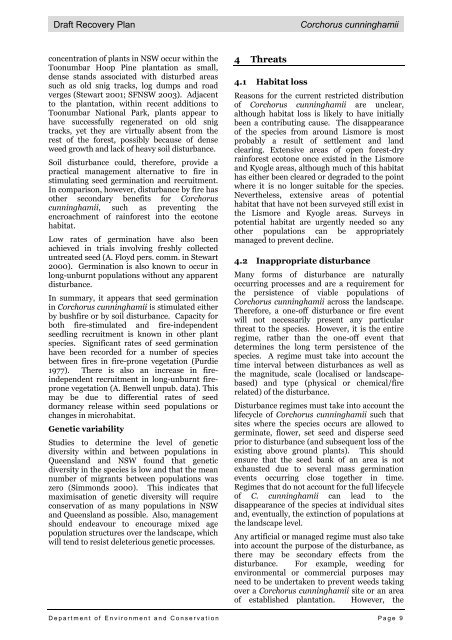Corchorus cunninghamii - Department of Environment and Climate ...
Corchorus cunninghamii - Department of Environment and Climate ...
Corchorus cunninghamii - Department of Environment and Climate ...
You also want an ePaper? Increase the reach of your titles
YUMPU automatically turns print PDFs into web optimized ePapers that Google loves.
Draft Recovery Plan <strong>Corchorus</strong> <strong>cunninghamii</strong><br />
concentration <strong>of</strong> plants in NSW occur within the<br />
Toonumbar Hoop Pine plantation as small,<br />
dense st<strong>and</strong>s associated with disturbed areas<br />
such as old snig tracks, log dumps <strong>and</strong> road<br />
verges (Stewart 2001; SFNSW 2003). Adjacent<br />
to the plantation, within recent additions to<br />
Toonumbar National Park, plants appear to<br />
have successfully regenerated on old snig<br />
tracks, yet they are virtually absent from the<br />
rest <strong>of</strong> the forest, possibly because <strong>of</strong> dense<br />
weed growth <strong>and</strong> lack <strong>of</strong> heavy soil disturbance.<br />
Soil disturbance could, therefore, provide a<br />
practical management alternative to fire in<br />
stimulating seed germination <strong>and</strong> recruitment.<br />
In comparison, however, disturbance by fire has<br />
other secondary benefits for <strong>Corchorus</strong><br />
<strong>cunninghamii</strong>, such as preventing the<br />
encroachment <strong>of</strong> rainforest into the ecotone<br />
habitat.<br />
Low rates <strong>of</strong> germination have also been<br />
achieved in trials involving freshly collected<br />
untreated seed (A. Floyd pers. comm. in Stewart<br />
2000). Germination is also known to occur in<br />
long-unburnt populations without any apparent<br />
disturbance.<br />
In summary, it appears that seed germination<br />
in <strong>Corchorus</strong> <strong>cunninghamii</strong> is stimulated either<br />
by bushfire or by soil disturbance. Capacity for<br />
both fire-stimulated <strong>and</strong> fire-independent<br />
seedling recruitment is known in other plant<br />
species. Significant rates <strong>of</strong> seed germination<br />
have been recorded for a number <strong>of</strong> species<br />
between fires in fire-prone vegetation (Purdie<br />
1977). There is also an increase in fireindependent<br />
recruitment in long-unburnt fireprone<br />
vegetation (A. Benwell unpub. data). This<br />
may be due to differential rates <strong>of</strong> seed<br />
dormancy release within seed populations or<br />
changes in microhabitat.<br />
Genetic variability<br />
Studies to determine the level <strong>of</strong> genetic<br />
diversity within <strong>and</strong> between populations in<br />
Queensl<strong>and</strong> <strong>and</strong> NSW found that genetic<br />
diversity in the species is low <strong>and</strong> that the mean<br />
number <strong>of</strong> migrants between populations was<br />
zero (Simmonds 2000). This indicates that<br />
maximisation <strong>of</strong> genetic diversity will require<br />
conservation <strong>of</strong> as many populations in NSW<br />
<strong>and</strong> Queensl<strong>and</strong> as possible. Also, management<br />
should endeavour to encourage mixed age<br />
population structures over the l<strong>and</strong>scape, which<br />
will tend to resist deleterious genetic processes.<br />
4 Threats<br />
4.1 Habitat loss<br />
Reasons for the current restricted distribution<br />
<strong>of</strong> <strong>Corchorus</strong> <strong>cunninghamii</strong> are unclear,<br />
although habitat loss is likely to have initially<br />
been a contributing cause. The disappearance<br />
<strong>of</strong> the species from around Lismore is most<br />
probably a result <strong>of</strong> settlement <strong>and</strong> l<strong>and</strong><br />
clearing. Extensive areas <strong>of</strong> open forest-dry<br />
rainforest ecotone once existed in the Lismore<br />
<strong>and</strong> Kyogle areas, although much <strong>of</strong> this habitat<br />
has either been cleared or degraded to the point<br />
where it is no longer suitable for the species.<br />
Nevertheless, extensive areas <strong>of</strong> potential<br />
habitat that have not been surveyed still exist in<br />
the Lismore <strong>and</strong> Kyogle areas. Surveys in<br />
potential habitat are urgently needed so any<br />
other populations can be appropriately<br />
managed to prevent decline.<br />
4.2 Inappropriate disturbance<br />
Many forms <strong>of</strong> disturbance are naturally<br />
occurring processes <strong>and</strong> are a requirement for<br />
the persistence <strong>of</strong> viable populations <strong>of</strong><br />
<strong>Corchorus</strong> <strong>cunninghamii</strong> across the l<strong>and</strong>scape.<br />
Therefore, a one-<strong>of</strong>f disturbance or fire event<br />
will not necessarily present any particular<br />
threat to the species. However, it is the entire<br />
regime, rather than the one-<strong>of</strong>f event that<br />
determines the long term persistence <strong>of</strong> the<br />
species. A regime must take into account the<br />
time interval between disturbances as well as<br />
the magnitude, scale (localised or l<strong>and</strong>scapebased)<br />
<strong>and</strong> type (physical or chemical/fire<br />
related) <strong>of</strong> the disturbance.<br />
Disturbance regimes must take into account the<br />
lifecycle <strong>of</strong> <strong>Corchorus</strong> <strong>cunninghamii</strong> such that<br />
sites where the species occurs are allowed to<br />
germinate, flower, set seed <strong>and</strong> disperse seed<br />
prior to disturbance (<strong>and</strong> subsequent loss <strong>of</strong> the<br />
existing above ground plants). This should<br />
ensure that the seed bank <strong>of</strong> an area is not<br />
exhausted due to several mass germination<br />
events occurring close together in time.<br />
Regimes that do not account for the full lifecycle<br />
<strong>of</strong> C. <strong>cunninghamii</strong> can lead to the<br />
disappearance <strong>of</strong> the species at individual sites<br />
<strong>and</strong>, eventually, the extinction <strong>of</strong> populations at<br />
the l<strong>and</strong>scape level.<br />
Any artificial or managed regime must also take<br />
into account the purpose <strong>of</strong> the disturbance, as<br />
there may be secondary effects from the<br />
disturbance. For example, weeding for<br />
environmental or commercial purposes may<br />
need to be undertaken to prevent weeds taking<br />
over a <strong>Corchorus</strong> <strong>cunninghamii</strong> site or an area<br />
<strong>of</strong> established plantation. However, the<br />
<strong>Department</strong> <strong>of</strong> <strong>Environment</strong> <strong>and</strong> Conservation Page 9

















